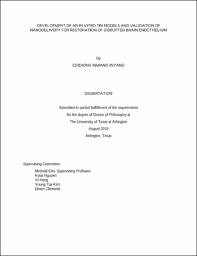
ATTENTION: The works hosted here are being migrated to a new repository that will consolidate resources, improve discoverability, and better show UTA's research impact on the global community. We will update authors as the migration progresses. Please see MavMatrix for more information.
Show simple item record
| dc.contributor.advisor | Cho, Michael | |
| dc.creator | Inyang, Edidiong I | |
| dc.date.accessioned | 2020-08-04T17:20:32Z | |
| dc.date.available | 2020-08-04T17:20:32Z | |
| dc.date.created | 2019-08 | |
| dc.date.issued | 2019-09-06 | |
| dc.date.submitted | August 2019 | |
| dc.identifier.uri | http://hdl.handle.net/10106/29302 | |
| dc.description.abstract | Blast-induced traumatic brain injury (bTBI) is a serious concern among military personnel and their families. Although the mechanisms responsible for disruption to the brain are not well understood, the development of reliable diagnosis along with effective therapeutic treatment is urgently warranted. Recent findings suggest that shockwaves produced by a blast can generate micron-size bubbles that subsequently collapse in the brain tissue. The collapse of microbubbles (referred to as microcavitation) may compromise the integrity of the blood-brain barrier (BBB). Moreover, addiction to the psycho-stimulant drugs (PSDs), e.g. cocaine and alcohol which are known to cause toxicity due to oxidative stress, can also adversely affect the BBB. One specific mechanism that has been proposed postulates the brain endothelium is compromised by traumatic events and therefore, the biotransport properties across the BBB are modulated. The injured brain endothelial cells (BECs) appear to express a high level of E-Selectins (CD62e), which typically indicates inflammation and activation of endothelial cells. Upregulation of this protein following a traumatic injury can be exploited for diagnosis and potential therapy through targeted drug nanodelivery. We, therefore, hypothesized that the collapsed microbubbles in the blood vessel and psychostimulants can modulate its structure and function, alter the glucose uptake and transport, and disrupt the energy requirement of the BBB as well as neurons. To test and validate this hypothesis, we applied tissue engineering techniques to fabricate a custom-designed cell culture chamber to mimic the structure and biotransport properties of the BBB and used it as a model to determine the effect of microcavitation and PSDs on the physical, mechanical, chemical, and biological changes in the brain endothelium and neurons. We also engineered nanoparticles that are (1) decorated with ligands to specifically bind the injured endothelial cells; and (2) loaded with therapeutic reagents (e.g., poloxamers and antioxidant) to facilitate restoration of BECs. In summary, engineering a biomimetic interface is proven to provide a systematic approach to replicate the structure and function of BBB and determine its alteration in response to mechanical and chemical traumas to the brain. | |
| dc.format.mimetype | application/pdf | |
| dc.language.iso | en_US | |
| dc.subject | Blood-brain barrier | |
| dc.subject | Traumatic brain injury | |
| dc.subject | Brain endothelial cells | |
| dc.subject | Zonular occludin | |
| dc.subject | Psychostimulants drugs | |
| dc.subject | Glucose transporter 1 | |
| dc.subject | Matrix metalloproteinases | |
| dc.subject | Tumor necrotic factor-alpha | |
| dc.subject | Nanoparticles | |
| dc.title | DEVELOPMENT OF AN IN VITRO TBI MODELS AND VALIDATION OF NANODELIVERY FOR RESTORATION OF DISRUPTED BRAIN ENDOTHELIUM | |
| dc.type | Thesis | |
| dc.degree.department | Bioengineering | |
| dc.degree.name | Doctor of Philosophy in Biomedical Engineering | |
| dc.date.updated | 2020-08-04T17:20:32Z | |
| thesis.degree.department | Bioengineering | |
| thesis.degree.grantor | The University of Texas at Arlington | |
| thesis.degree.level | Doctoral | |
| thesis.degree.name | Doctor of Philosophy in Biomedical Engineering | |
| dc.type.material | text | |
| dc.creator.orcid | 0000-0002-6639-6541 | |
Files in this item
- Name:
- INYANG-DISSERTATION-2019.pdf
- Size:
- 6.961Mb
- Format:
- PDF
This item appears in the following Collection(s)
Show simple item record


